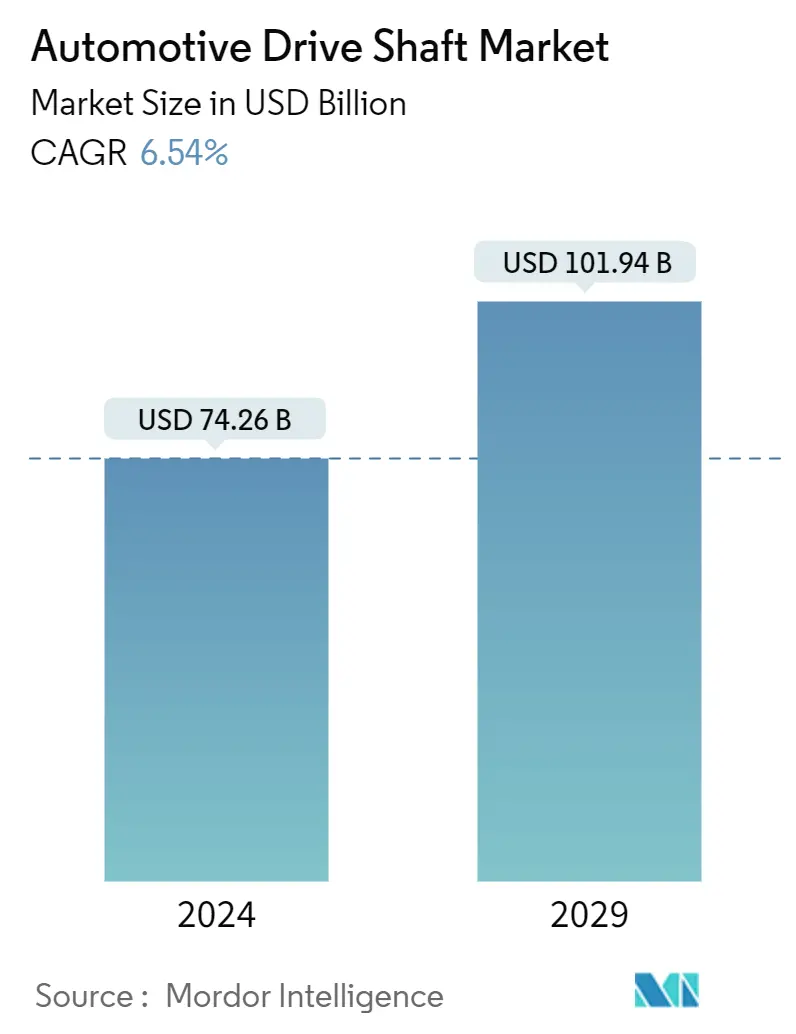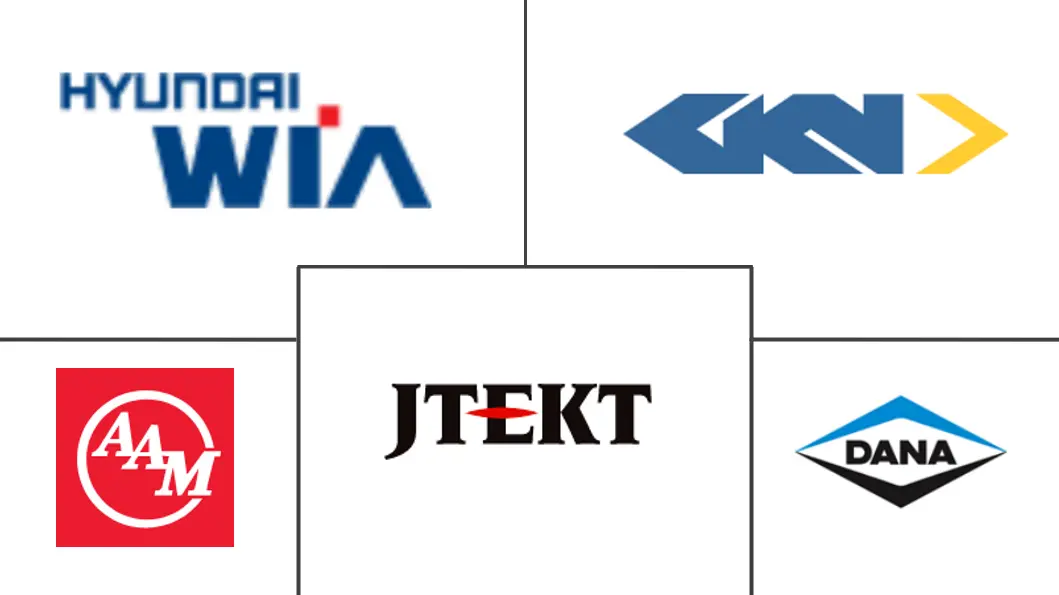Market Size of Automotive Drive Shaft Industry

| Study Period | 2019 - 2029 |
| Market Size (2024) | USD 74.26 Billion |
| Market Size (2029) | USD 101.94 Billion |
| CAGR (2024 - 2029) | 6.54 % |
| Fastest Growing Market | Asia-Pacific |
| Largest Market | Asia-Pacific |
| Market Concentration | Medium |
Major Players
*Disclaimer: Major Players sorted in no particular order |
Automotive Drive Shaft Market Analysis
The Automotive Drive Shaft Market size is estimated at USD 74.26 billion in 2024, and is expected to reach USD 101.94 billion by 2029, growing at a CAGR of 6.54% during the forecast period (2024-2029).
Over the medium term, with the rising population and disposable income, the demand for automobiles, such as passenger cars and commercial vehicles, is expected to grow worldwide. The increasing production and manufacturing of automobiles are fueling the demand for drive shafts globally.
The market will likely be the focus of attention during the forecast period, driven by the growing demand for commercial vehicles and buses, both of which are expected to drive global vehicle production and sales. This trend is primarily due to the growing demand for electric vehicles. In addition, automakers are putting all their efforts into making the most energy-efficient electric vehicles as their demand grows. Driveshaft manufacturers are updating their product lines to meet the constantly shifting needs of OEMs and expand their market share.
Considering the future of electric vehicles, the major OEM companies, including Volkswagen and General Motors, are investing majorly in new technology, establishing supply chains, and increasing the production capacity of EVs and their components, such as battery packs and motors. For instance:
- In June 2023, Mercedes-Benz announced an investment of billions in its European assembly plants to equip them for the shift to electric cars by the end of the decade. This move involves the production of vehicles on the new electric platforms and their components to be introduced in 2025.
The automotive drive shaft market is anticipated to grow in the coming years, driven by trends such as the rising demand for lightweight components and the increasing sales of all-wheel-drive vehicles. One notable factor that is anticipated to impact the overall growth of the automotive drive shaft market in the coming years is the sharp increase in utility vehicle sales worldwide. Asia-Pacific is distinguished by the presence of emerging economies and accounts for about half of global vehicle sales.
The Asia-Pacific automotive drive shaft market is expected to hold the largest share and register the highest growth rate in the coming years. Asia-Pacific is characterized by the presence of emerging economies and accounts for a major share of global vehicle sales, which may continue over the forecast period.
Countries such as China, the United States, and Norway are continuing to see stronger demand for electric vehicles. Automakers are planning to launch more EV models in the coming years. The majority of the present and upcoming EV models are all-wheel drives (AWD) or rear-wheel drives (RWD), which may generate the demand for lightweight drive shafts during the forecast period.
Automotive Drive Shaft Industry Segmentation
An automotive drive shaft or propeller shaft transfers the power produced by the engine from the transmission to the rear axle or front axle. The application of extruded aluminum in drive shafts has been the most notable for rear-wheel or all-wheel drive vehicles, both for the tubes and the Cardan links.
The automotive drive shaft market is segmented into design type, position type, vehicle type, sales channel, and geography. By design type, the market is segmented into hollow shafts and solid shafts. By position type, the market is segmented into rear axle and front axle. By vehicle type, the market is segmented into passenger cars and commercial vehicles. By sales channel, the market is segmented into OEM and aftermarket. By geography, the market is segmented into North America, Europe, Asia-Pacific, and Rest of the world.
The report offers market size and forecasts in value (USD) and volume (units) for all the above segments.
| By Design Type | |
| Hollow Shaft | |
| Solid Shaft |
| By Position Type | |
| Rear Axle | |
| Front Axle |
| By Vehicle Type | |
| Passenger Cars | |
| Commercial Vehicles |
| By Sales Channel | |
| OEM | |
| Aftermarket |
| By Geography | |||||||
| |||||||
| |||||||
| |||||||
|
Automotive Drive Shaft Market Size Summary
The automotive drive shaft market is poised for significant growth over the forecast period, driven by the increasing demand for automobiles globally, including both passenger and commercial vehicles. This growth is largely attributed to rising population and disposable income levels, which are fueling the demand for vehicles. The market is further bolstered by the surge in electric vehicle production, as automakers strive to enhance energy efficiency and meet evolving consumer preferences. Major automotive manufacturers are investing heavily in new technologies and expanding production capacities to accommodate the growing demand for electric vehicles and their components. This shift towards electric vehicles is also prompting drive shaft manufacturers to innovate and update their product lines to align with the needs of original equipment manufacturers (OEMs).
The Asia-Pacific region is expected to dominate the automotive drive shaft market, driven by emerging economies like China and India, which are witnessing robust vehicle sales and production. The region's growth is supported by government incentives and subsidies aimed at boosting electric vehicle adoption and expanding the automotive industry. The increasing sales of all-wheel-drive vehicles and the demand for lightweight components are also contributing to market expansion. Additionally, the market is characterized by the presence of established global and regional players who are employing strategies such as new product launches and collaborations to maintain their market positions. As the market evolves, the focus on innovative materials and manufacturing processes is expected to play a crucial role in meeting the demands of modern vehicles, including electric and hybrid models.
Automotive Drive Shaft Market Size - Table of Contents
-
1. MARKET DYNAMICS
-
1.1 Market Drivers
-
1.1.1 Increasing Government Policies to Promote EV Sales
-
-
1.2 Market Restraints
-
1.2.1 High Cost of Maintenance Related to Drive Shafts
-
-
1.3 Porter's Five Forces Analysis
-
1.3.1 Threat of New Entrants
-
1.3.2 Bargaining Power of Buyers/Consumers
-
1.3.3 Bargaining Power of Suppliers
-
1.3.4 Threat of Substitute Products
-
1.3.5 Intensity of Competitive Rivalry
-
-
-
2. MARKET SEGMENTATION (Market Size in Value - USD)
-
2.1 By Design Type
-
2.1.1 Hollow Shaft
-
2.1.2 Solid Shaft
-
-
2.2 By Position Type
-
2.2.1 Rear Axle
-
2.2.2 Front Axle
-
-
2.3 By Vehicle Type
-
2.3.1 Passenger Cars
-
2.3.2 Commercial Vehicles
-
-
2.4 By Sales Channel
-
2.4.1 OEM
-
2.4.2 Aftermarket
-
-
2.5 By Geography
-
2.5.1 North America
-
2.5.1.1 United States
-
2.5.1.2 Canada
-
2.5.1.3 Rest of North America
-
-
2.5.2 Europe
-
2.5.2.1 Germany
-
2.5.2.2 United Kingdom
-
2.5.2.3 France
-
2.5.2.4 Rest of Europe
-
-
2.5.3 Asia-Pacific
-
2.5.3.1 India
-
2.5.3.2 China
-
2.5.3.3 Japan
-
2.5.3.4 South Korea
-
2.5.3.5 Rest of Asia-Pacific
-
-
2.5.4 Rest of the World
-
2.5.4.1 South America
-
2.5.4.2 Middle East and Africa
-
-
-
Automotive Drive Shaft Market Size FAQs
How big is the Automotive Drive Shaft Market?
The Automotive Drive Shaft Market size is expected to reach USD 74.26 billion in 2024 and grow at a CAGR of 6.54% to reach USD 101.94 billion by 2029.
What is the current Automotive Drive Shaft Market size?
In 2024, the Automotive Drive Shaft Market size is expected to reach USD 74.26 billion.

